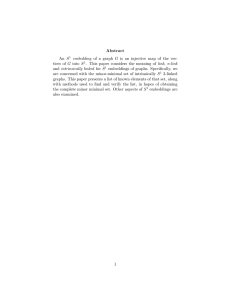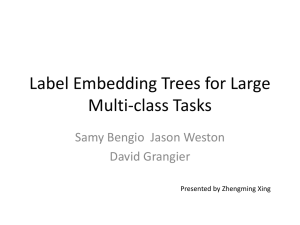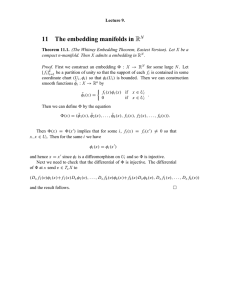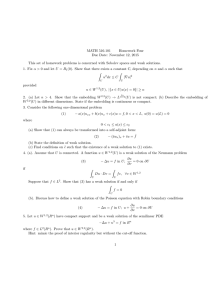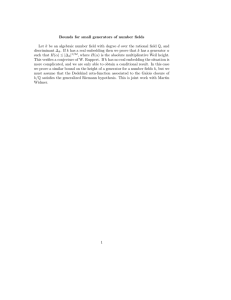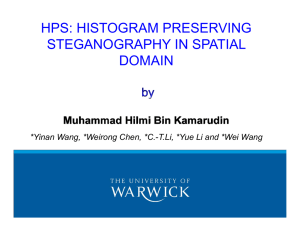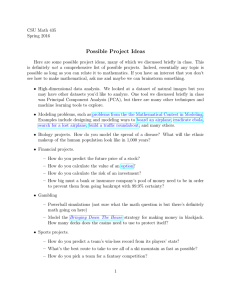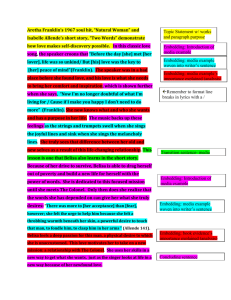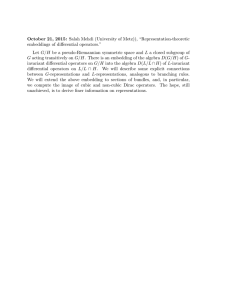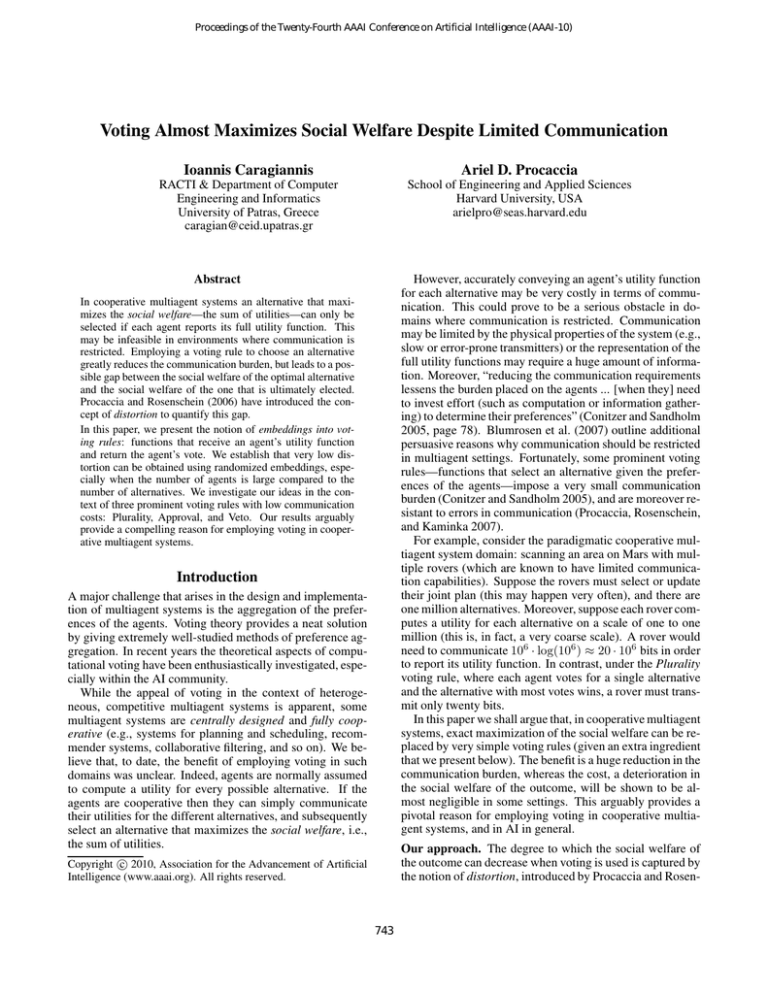
Proceedings of the Twenty-Fourth AAAI Conference on Artificial Intelligence (AAAI-10)
Voting Almost Maximizes Social Welfare Despite Limited Communication
Ioannis Caragiannis
Ariel D. Procaccia
RACTI & Department of Computer
Engineering and Informatics
University of Patras, Greece
caragian@ceid.upatras.gr
School of Engineering and Applied Sciences
Harvard University, USA
arielpro@seas.harvard.edu
Abstract
However, accurately conveying an agent’s utility function
for each alternative may be very costly in terms of communication. This could prove to be a serious obstacle in domains where communication is restricted. Communication
may be limited by the physical properties of the system (e.g.,
slow or error-prone transmitters) or the representation of the
full utility functions may require a huge amount of information. Moreover, “reducing the communication requirements
lessens the burden placed on the agents ... [when they] need
to invest effort (such as computation or information gathering) to determine their preferences” (Conitzer and Sandholm
2005, page 78). Blumrosen et al. (2007) outline additional
persuasive reasons why communication should be restricted
in multiagent settings. Fortunately, some prominent voting
rules—functions that select an alternative given the preferences of the agents—impose a very small communication
burden (Conitzer and Sandholm 2005), and are moreover resistant to errors in communication (Procaccia, Rosenschein,
and Kaminka 2007).
For example, consider the paradigmatic cooperative multiagent system domain: scanning an area on Mars with multiple rovers (which are known to have limited communication capabilities). Suppose the rovers must select or update
their joint plan (this may happen very often), and there are
one million alternatives. Moreover, suppose each rover computes a utility for each alternative on a scale of one to one
million (this is, in fact, a very coarse scale). A rover would
need to communicate 106 · log(106 ) ≈ 20 · 106 bits in order
to report its utility function. In contrast, under the Plurality
voting rule, where each agent votes for a single alternative
and the alternative with most votes wins, a rover must transmit only twenty bits.
In this paper we shall argue that, in cooperative multiagent
systems, exact maximization of the social welfare can be replaced by very simple voting rules (given an extra ingredient
that we present below). The benefit is a huge reduction in the
communication burden, whereas the cost, a deterioration in
the social welfare of the outcome, will be shown to be almost negligible in some settings. This arguably provides a
pivotal reason for employing voting in cooperative multiagent systems, and in AI in general.
In cooperative multiagent systems an alternative that maximizes the social welfare—the sum of utilities—can only be
selected if each agent reports its full utility function. This
may be infeasible in environments where communication is
restricted. Employing a voting rule to choose an alternative
greatly reduces the communication burden, but leads to a possible gap between the social welfare of the optimal alternative
and the social welfare of the one that is ultimately elected.
Procaccia and Rosenschein (2006) have introduced the concept of distortion to quantify this gap.
In this paper, we present the notion of embeddings into voting rules: functions that receive an agent’s utility function
and return the agent’s vote. We establish that very low distortion can be obtained using randomized embeddings, especially when the number of agents is large compared to the
number of alternatives. We investigate our ideas in the context of three prominent voting rules with low communication
costs: Plurality, Approval, and Veto. Our results arguably
provide a compelling reason for employing voting in cooperative multiagent systems.
Introduction
A major challenge that arises in the design and implementation of multiagent systems is the aggregation of the preferences of the agents. Voting theory provides a neat solution
by giving extremely well-studied methods of preference aggregation. In recent years the theoretical aspects of computational voting have been enthusiastically investigated, especially within the AI community.
While the appeal of voting in the context of heterogeneous, competitive multiagent systems is apparent, some
multiagent systems are centrally designed and fully cooperative (e.g., systems for planning and scheduling, recommender systems, collaborative filtering, and so on). We believe that, to date, the benefit of employing voting in such
domains was unclear. Indeed, agents are normally assumed
to compute a utility for every possible alternative. If the
agents are cooperative then they can simply communicate
their utilities for the different alternatives, and subsequently
select an alternative that maximizes the social welfare, i.e.,
the sum of utilities.
Our approach. The degree to which the social welfare of
the outcome can decrease when voting is used is captured by
the notion of distortion, introduced by Procaccia and Rosen-
c 2010, Association for the Advancement of Artificial
Copyright Intelligence (www.aaai.org). All rights reserved.
743
ative point” to one alternative). Plurality and Veto have the
smallest communication burden among all prominent voting
rules: only log m bits per agent, where m is the number of
alternatives. Approval requires more communication, m bits
per agent, but still less than other prominent voting rules.
We first deal with the Plurality rule. We show that any deterministic embedding into Plurality has distortion Ω(m2 ),
and also provide a matching upper bound. Our main result
deals with randomized embeddings into Plurality: we show
that the naı̈ve embedding into Plurality, which selects an alternative with probability proportional to its utility, yields
constant distortion when n = Ω(m ln m), where n is the
number of agents, and has extremely low distortion, specifically 1 + o(1), for larger values of n.
Next we investigate the Approval rule. We give a lower
bound of Ω(m) for deterministic embeddings, and also
present a matching upper bound. Our randomized upper
bounds for Approval follow directly from the upper bounds
for Plurality, since any embedding into Plurality is also an
embedding into Approval.
Finally, we consider the Veto rule. We show that any deterministic embedding into Veto has infinite distortion, and
the same is true for randomized embeddings if n < m − 1.
We further show that low-distortion embeddings into Veto
can be obtained, albeit using a large number of agents.
schein (2006). They focus on voting rules that receive as input a ranking of the alternatives, and, crucially, assume that
each agent reports a ranking such that the alternative that is
ranked in the k’th place has the k’th highest utility. Under
this assumption, they define the distortion of a voting rule to
be the worst-case ratio between the maximum social welfare
over all the alternatives, and the social welfare of the winner
of the election; the worst-case is taken over all the possible
utility functions of the agents. After proving some impossibility results, Procaccia and Rosenschein further restrict the
structure of the utility functions. Even under this additional
(very strong) assumption, they show that the distortion of
most prominent voting rules is linear in the number of alternatives. The approach of Procaccia and Rosenschein is
descriptive: they propose to use the notion of distortion as a
criterion in the comparison of different voting rules.
Our main conceptual contribution is the consideration of
embeddings into voting rules. An embedding is a set of instructions that informs each agent how to vote, based only on
the agent’s own utility function, that is, without any communication or coordination between different agents. More accurately, an embedding into a specific voting rule is a function from utility functions to votes that are valid under the
voting rule. For instance, consider the simple Plurality rule
described above. Given a utility function, an embedding into
Plurality returns the alternative that the agent votes for. Procaccia and Rosenschein implicitly use one specific embedding, but many different embeddings exist. In this sense, our
approach is algorithmic: we wish to design embeddings in a
way that minimizes the distortion.
We redefine the notion of distortion to take embeddings
into account. The distortion of an embedding into a voting
rule is still the worst-case ratio between the maximum social welfare and the social welfare of the winner, but now
the winner depends both on the voting rule and on the embedding, that is, on the way the utilities of the agents are
translated into votes. The worst-case is taken over all possible utilities; we do not make any assumption regarding the
utilities, except that they are normalized.
We take the idea of embeddings into voting rules one step
further by allowing randomized embeddings. A randomized
embedding randomly chooses the agent’s vote, according to
some probability distribution. The distortion is defined similarly, by taking into account the expected social welfare of
the winner of the election. As we shall see, randomization
gives us great power and flexibility, and ultimately provides
us with the tools to design truly low-distortion embeddings.
We wish to design low distortion embeddings into voting
rules with low communication complexity. Indeed, given
that each of our cooperative agents votes according to the
instructions provided by the embedding (in a fully decentralized way), then an alternative with social welfare close
to optimal may be elected in the face of restricted communication. We find the existence of low distortion embeddings
rather striking, as the social welfare is a centralized concept.
Embeddings into Plurality
We denote by N = {1, . . . , n} the set of agents, and by A,
|A| = m, the set of alternatives.
We assume that the agents have normalized cardinal utilities over A. Specifically, let U = U(A) be the set of utility
functions
u over A such that for each x ∈ A, u(x) ≥ 0, and
P
u(x)
= 1. Each agent i has a utility function u ∈ U.
x∈A
A utility profile is a vector of utility functions
u = hu1 , . . . , un i ∈ U n .
The social welfare of an alternative x ∈ A with respect to
u ∈ U n , denoted sw(x, u), is the sum of the utilities of x
for all agents:
X
sw(x, u) =
ui (x) .
i∈N
In our formal presentation, a voting rule is defined as a
function that selects a set of alternatives rather than a single alternative. Such a function is formally known as a voting correspondence, hence the term voting rule is slightly
abused. We must deal with sets of winners since our rules
are based on notions of score, and there might be a tie with
respect to the maximum score.
Under the Plurality rule, each agent casts its vote in favor of a single alternative. The set of winners is the set of
alternatives with a maximum number of votes.
A deterministic embedding into Plurality is a function f :
U → A. Informally, given an agent i ∈ N with a utility
function u ∈ U, f (u) is the alternative which agent i votes
for under the embedding f . Given a utility profile u ∈ U n
and an embedding f , denote the (Plurality) score of x ∈ A
by
sc(x, f, u) = |{i ∈ N : f (ui ) = x}| ,
Our results. We study the distortion of embeddings into
three voting rules: Plurality, Approval (each agent approves
a subset of alternatives), and Veto (each agent gives a “neg-
744
and denote the set of winners by
winners, since the set of winners is simply a random variable
that takes values in 2A , hence minx∈win(f,u) sw(x, u) is a
random variable that takes values in the interval [0, n] and
its expectation is well-defined. The rest of the definition is
identical to the deterministic case.
win(f, u) = argmaxx∈A sc(x, f, u) .
Note that the argmax function returns a set of maximal alternatives.
A randomized embedding randomly selects one of the
alternatives, that is, it is a function f : U → ∆(A),
where ∆(A) is the space of probability distributions over
A. Put another way, given u ∈ U, f (u) is a random variable that takes the value x ∈ A with probability p(x), i.e.,
P
x∈A p(x) = 1. With respect to a randomized embedding f , sc(x, f, u) is a random variable that takes values
in {1, . . . , n}, and win(f, u) is a random variable that takes
values in 2A , the powerset of A. Less formally, given a randomized embedding f , a utility profile u, and S ⊆ A, we
have some probability (possibly zero) of S being the set of
winners when f is applied to u.
As a measure of the quality of an embedding, we use
the notion of distortion, introduced by Procaccia and Rosenschein (2006), but adapt it to apply to general embeddings.
Deterministic Embeddings
Procaccia and Rosenschein (2006) consider a specific, naı̈ve
deterministic embedding into Plurality. Their embedding
simply maps a utility function u ∈ U to an alternative with
maximum utility, that is, f (u) ∈ argmaxx∈A u(x). They
show that its distortion is m − 1 under a very restricted definition of distortion (called misrepresentation) that assumes
a specific structure of utility functions.
It is easy to see that the distortion of this naı̈ve embedding,
according to Definition 1, is at most m2 . Indeed, let u ∈ U,
and let x ∈ win(f, u), where f is the naı̈ve embedding.
By the Pigeonhole Principle, it must hold that sc(x, f, u) ≥
n/m. Now, for each agent i ∈ N such that f (ui ) = x, it
must hold that ui (x) ≥ 1/m, since x has maximum utility
and there must exist an alternative with utility 1/m (again,
by the Pigeonhole principle). We deduce that sw(x, u) ≥
n/m2 . On the other hand, for any y ∈ A, sw(y, u) ≤ n.
Therefore,
Definition 1 (Distortion).
1. Let f : U → A be a deterministic embedding, u ∈ U n .
The distortion of f at u is
dist(f, u) =
maxy∈A sw(y, u)
.
minx∈win(f,u) sw(x, u)
dist(f ) = maxn
u∈U
We wish to ask whether there is a clever deterministic embedding into Plurality that beats the m2 upper bound given
by the naı̈ve one. Our first theorem answers this question in
the negative.
Theorem 2. Let |A| = m ≥ 3, |N | = n ≥ m+1
, and
2
let f : U → A be a deterministic embedding into Plurality.
Then dist(f ) = Ω(m2 ).
2. Let f : U → ∆(A) be a randomized embedding, u ∈ U n .
The distortion of f at u is
dist(f, u) =
maxy∈A sw(y, u)
n
≤
= m2 .
minx∈win(f,u) sw(x, u)
n/m2
maxy∈A sw(y, u)
.
E minx∈win(f,u) sw(x, u)
3. Let f be a deterministic or randomized embedding. The
distortion of f is
Proof. Let f be a deterministic embedding into Plurality.
For every pair of distinct alternatives x, y ∈ A, let uxy ∈ U
such that uxy (x) = 1/2, uxy (y) = 1/2, and u(z) = 0
for every z ∈ A \ {x, y}. We claim that we can assume that f (uxy ) ∈ {x, y}, since otherwise the distortion
is infinite. Indeed, if f (uxy ) = z ∈
/ {x, y}, then consider a utility profiles u where ui ≡ uxy for all i ∈ N .
Then win(f, u) = {z}, but sw(z, u) = 0, whereas, say,
sw(x, u) = n/2 > 0.
Let T be a tournament on A, that is, a complete asymmetric binary relation (see, e.g., (Moon 1968)). For every two
alternatives x, y ∈ A, we have that xT y (read: x dominates
y) if f (uxy ) = x, and yT x if f (uxy ) = y. By our claim
above, T is well-defined.
Since the number of pairs of alternatives is m
=
2
m(m−1)
, by the Pigeonhole Principle there must be an alter2
native that is dominated by at least m−1
other alternatives;
2
′
without loss of generality this alternative
m−1 is a ∈ A. Let A
be a subset of alternatives of size
such
that
for
all
2
x ∈ A′ , xT a. Further,
let A′′ = A \ (A′ ∪ {a}) and no
. Define a utility function u∗ ∈ U
tice that |A′′ | = m−1
2
as follows: for every x ∈ A′′ , u∗ (x) = 1/|A′′ |; for every
x ∈ A \ A′′ , u∗ (x) = 0. Then without loss of generality
dist(f ) = maxn dist(f, u) .
u∈U
Let us give an intuitive interpretation of this important
definition. The distortion of a deterministic embedding is the
worst-case ratio between the social welfare of the most popular alternative, and the social welfare of the least popular
winner, where the worst-case is with respect to all possible
utility profiles. In other words, we are interested in the question: how small can the social welfare of one of the winners
be, when compared to the alternative with maximum social
welfare?
Our focus on the social welfare of the “worst” winner is
appropriate since the analysis is worst-case. Alternatively,
it is possible to think of voting rules that elect only one
of the alternatives with maximum score, but in the worstcase the most unpopular one is elected, that is, in the worstcase ties are broken in favor of alternatives with lower social
welfare; this is the interpretation of Procaccia and Rosenschein (2006).
The definition of distortion with respect to randomized
embeddings is slightly more subtle. Here there is no definite
winner. However, given a utility profile u ∈ U, we can
talk about the expected minimum social welfare among the
745
f (u∗ ) = b, with b ∈ A′′ , otherwise the distortion is infinite
by the same reasoning as above.
Now, we have A′ + 1 blocks of agents, each of size either
⌈n/(|A′ | + 1)⌉ or ⌊n/(|A′ | + 1)⌋. All the agents in the first
block, which is at least as large as any other, have the utility
function u∗ (therefore they vote for b). For each x ∈ A′ ,
there is a block of agents with the utility function uax (hence
they vote for x). Given this utility profile u, b must be among
the winners, that is, b ∈ win(f, u). We have that
'
&
n
1
8n
sw(b, u) ≤ m−1 · m−1 ≤ 2 ,
m
+1
2
2
3. Let n ≥ 3 and ǫ(n, m) = 4
dist(f ) ≤
sw(a, u) ≥
n
n − m−1 2
+1
'!
·
n
1
≥
.
2
6
The distortion is at least as large as the ratio between the
maximum social welfare and the social welfare of a winner
with respect to the specific utility profile u, that is,
dist(f ) ≥ dist(f, u) ≥
m ln n
n .
If ǫ(n, m) < 1, then
All three bounds on the distortion are required, since each
has values of n and m where its guarantees are stronger than
the others. Asymptotically, the most powerful bound is the
one given in Part 1: it guarantees that the distortion of Embedding 1 is already constant when n = Θ(m ln m), that is,
when the number of agents is slightly larger than the number of alternatives. Part 1 yields a very weak result for the
case n = √
m; in this case, we get by Part 2 that the distortion is O ( m). Finally, for large values of n we do not find
it sufficient to show that the distortion is constant, we want
to establish that it is almost one. This does not follow from
Part 1 due to the constant hidden in the O notation. However, from Part 3 we get that for, e.g., n ≥ m2 , the distortion
is 1 + o(1).
We presently prove Part 1 of the theorem, which is the
easiest one. Part 2 is similar but slightly more involved. The
proof of Part 3 is quite different and significantly more complicated. We relegate the proofs of Parts 2 and 3 to the full
version of the paper. Before proving Part 1, we require two
results regarding the sums of random variables (many more
such results are required for Part 3).
whereas
&
1
1−ǫ(n,m) .
q
sw(a, u∗ )
= Ω(m2 ) .
sw(b, u∗ )
Lemma 5. Let X1 , ..., Xn be independent heterogeneous
Bernoulli trials.
PDenote by µ the expectation of the random
variable X = i Xi . Then:
Randomized Embeddings
Theorem 2 implies that the distortion of any deterministic
embedding into Plurality is quite high. Can we do better
using randomized embeddings? In general, the answer is
definitely positive. However, we start our investigation of
randomized embeddings into Plurality with a negative result
that holds when the number of agents is very small.
Theorem 3. Let |N | = {1, 2} and |A| = m. Then any
randomized embedding f : U → ∆(A) into Plurality has
distortion Ω(m).
The idea of the proof (which appears in the full version of
the paper) is the design of a utility profile where agent 1 has
equal utility for all alternatives, whereas agent 2 has utility 1
for one special alternative. Although the special alternative
has high social welfare, it is the unique winner with small
probability.
We presently turn to our presentation of low-distortion
embeddings. It turns out that when the number of agents
is at least as large as the number of alternatives, a huge reduction in the distortion can be achieved using randomized
embeddings. If the number of agents is significantly larger,
the distortion can be very close to one. Indeed, consider the
following embedding.
Embedding 1 (Naı̈ve randomized embedding into Plurality). Given a utility function u ∈ U, select alternative x ∈ A
with probability u(x).
The following powerful theorem is our main result.
Theorem 4. Let |N | = n ≥ m = |A|, and denote Embedding 1 by f . Then:
1. dist(f ) = O m2m/n .
√
2. dist(f ) = O ( m).
1. (Jogdeo and Samuels 1968) Pr[X < ⌊µ⌋] < 1/2 .
(1+δ)µ
e
.
2. (Chernoff 1952) Pr [X ≥ (1 + δ)µ] ≤ 1+δ
Proof of Part 1 of Theorem 4. Let u ∈ U n be a utility
profile. First notice that the expected Plurality score of
x ∈ A under the embedding f is sw(x, u). Let x∗ ∈
argmaxx∈A sw(x, u) bePan alternative with maximum social
welfare. We have that x∈A sw(x, u) = n; by the assumption that n ≥ m, it follows that sw(x∗ , u) ≥ n/m ≥ 1. By
Part 1 of Lemma 5, with probability at least 1/2 it holds that
sc(x∗ , f, u) ≥ ⌊sw(x∗ , u)⌋.
Consider some alternative x ∈ A such that
sw(x, u) <
sw(x∗ , u)
.
2e(4m)2m/n
(1)
We apply the upper tail Chernoff bound (Part 2 of Lemma 5)
to the random variable sc(x, f, u) with expectation µ =
sw(x, u) using (1 + δ)µ = ⌊sw(x∗ , u)⌋. By (1) and
since ⌊sw(x∗ , u)⌋ > sw(x∗ , u)/2, we also have 1 + δ >
e(4m)2m/n . Therefore,
⌊sw(x∗ ,u)⌋
1
∗
Pr[sc(x, f, u) ≥ ⌊sw(x , u)⌋] ≤
(4m)2m/n
sw(x∗ ,u)/2
1
≤
(4m)2m/n
1
≤
,
4m
where the last inequality follows since sw(x∗ , u) ≥ n/m.
746
Theorem 7. Let |N | = n, |A| = m, and denote Embedding 2 by f . Then dist(f ) ≤ 2m − 1.
Unfortunately, it is impossible to design low-distortion
deterministic embeddings into Approval. In fact, the following theorem asserts that the simple Embedding 2 is asymptotically optimal.
Theorem 8. Let |N | = n ≥ 2, |A| = m ≥ 3, and let
f : U → 2A be a deterministic embedding into Approval.
Then dist(f ) ≥ (m − 1)/2.
The proof of the theorem is given in the full version of the
paper.
By the union bound, the probability that either
sc(x∗ , f, u) < ⌊sw(x∗ , u)⌋, or some alternative x that satisfies (1) has sc(x, f, u) ≥ ⌊sw(x∗ , u)⌋, is at most 3/4.
Therefore, with probability 1/4 all the winners have social
welfare at least sw(x∗ , u)/(2e(4m)2m/n ). Hence
dist(f, u) ≤
sw(x∗ , u)
1
4
·
sw(x∗ ,u)
2e(4m)2m/n
= 8e · (4m)2m/n .
Since n ≥ m, we have that 42m/n ≤ 16. It follows that the
distortion of f is as announced.
Our final result regarding embeddings
into Plurality as√
serts that the upper bound of O ( m) for the case of n = m,
which follows from Part 2 of Theorem 4, is almost tight.
This case is especially interesting since for slightly larger
values of n the distortion is constant.
Theorem 6. Let |N | = n = m p
= |A|,and denote Embedm
ding 1 by f . Then dist(f ) = Ω
ln m .
The proof of the theorem appears in the full version of
the paper. The main idea is the construction of a utility
profile with “heavy” (high social welfare) alternatives and
“light” (low social welfare) alternatives; the heavy alternatives have social welfare and score of exactly two, whereas
the light alternatives have low social welfare and expected
score. However, since there are many light alternatives, with
high probability at least one such alternative has a score of
two.
Randomized Embeddings
In the context of deterministic embeddings, we have seen
that there is a gap between the distortion of embeddings into
Approval and embeddings into Plurality. It turns out that
there is also a huge gap with respect to randomized embeddings, when the number of agents is very small.
Indeed, consider the randomized embedding f into Approval that, with probability 1/2, approves an alternative
with maximum utility, and with probability 1/2 approves all
the alternatives. Further, assume that N = {1, 2}, and let
u ∈ U 2 . Without loss of generality there exists x∗ ∈ A
such that u1 (x∗ ) ≥ ui (x) for all x ∈ A and all i ∈ N .
Then clearly, for every x ∈ A, sw(x, u) ≤ 2 · sw(x∗ , u).
Moreover, it holds that win(f, u) = {x∗ } with probability at
least 1/4. Hence, the distortion of this embedding is at most
eight, i.e., constant. This reasoning can easily be extended
to obtain constant distortion with respect to any constant n.
Compare this result with Theorem 3.
However, as before, we are mostly interested in the case
of a large number of agents. Crucially, every embedding
into Plurality can also be seen as an embedding into Approval, where for every utility function exactly one alternative is approved. Hence, the powerful positive result regarding Embedding 1, namely Theorem 4, also holds with
respect to Approval. It remains open whether there is a gap
in the distortion of randomized embeddings into Plurality
and randomized embeddings into Approvalp
when n ≥ m.
Interestingly enough, the lower bound of Ω( m/ ln m) for
n = m (Theorem 6) also holds with respect to some natural embeddings into Approval, which may approve multiple
alternatives.
Embeddings into Approval
Under the Approval rule, each agent approves a subset of the
alternatives. Each approved alternative receives one point.
The set of winners includes the alternatives with most points,
summed over all the agents.
We must reformulate some of our definitions in order to
apply our notions to Approval voting. A deterministic embedding into Approval is a function f : U → 2A , where
2A is the powerset of alternatives. In words, an agent with a
utility function u approves each of the alternatives in f (u).
The (Approval) score of an alternative is redefined to be
sc(x, f, u) = |{i ∈ N : x ∈ f (ui )}| .
A randomized embedding is a function f : U → ∆(2A ).
The rest of the definitions (in particular, the definition of
distortion) are the same as before.
Embeddings into Veto
Deterministic Embeddings
Under the Veto rule, each agent vetoes a single (presumably
least preferred) alternative. The set of winners includes all
the alternatives that are vetoed the least number of times.
Equivalently, each agent awards one point to all the alternatives except one, and the alternatives with most points are
the winners.
Let us quickly reformulate our definitions for Veto. A
deterministic embedding into Veto is a function f : U → A,
as with Plurality; however, now f (u) is interpreted as the
alternative vetoed by an agent with utility function u. The
(Veto) score of an alternative is
In Section we have seen that no deterministic embedding
into Plurality can achieve distortion better than Ω(m2 ) (Theorem 2). As it turns out, better results can be achieved with
respect to Approval. Indeed, consider the following Embedding.
Embedding 2 (Deterministic embedding into Approval).
Given a utility function u, approve the subset of alternatives
x ∈ A such that u(x) ≥ 1/m.
The following straightforward result (whose proof appears in the full version of the paper) establishes that the
distortion of this embedding is O(m).
sc(x, f, u) = |{i ∈ N : x 6= f (ui )}| ,
747
that is, the number of agents that do not veto x. A randomized embedding is, once again, a function f : U → ∆(A).
Theorem 11. Let n = |N | ≥ |A| = m, and let f : U →
∆(A) be
√ a randomized embedding into Veto. Then dist(f ) =
Ω (m/ n).
This statement provides a necessary condition n =
Ω(m2 ) in order to obtain constant distortion into Veto,
whereas Embedding 1 yields a constant upper bound when
n = Θ(m ln m) with respect to Plurality and Approval.
Hence, randomized embeddings into Veto are provably less
efficient even when the number of agents is larger than the
number of alternatives.
Deterministic Embeddings
The Plurality and Veto rules are closely related in the sense
that agents must award an equal number of points to almost
all the alternatives, and therefore cannot make a distinction
in their votes between very desirable and very undesirable
alternatives. However, this turns out to be a more acute
problem under Veto, since agents cannot even single out one
good alternative. The following easy result formalizes this
intuition.
Theorem 9. Let |N | = n ≥ 1 and |A| = m ≥ 3, and let
f : U → A be a deterministic embedding into Veto. Then
dist(f ) = ∞.
Discussion
Our notion of embeddings into voting rules is extremely decentralized, that is, the agents cast their votes independently
according to the embedding. On the other extreme, if full coordination is allowed, the distortion would always be one, as
the agents would be able to find out which alternative maximizes social welfare and coordinate their votes in a way that
this alternative is elected (assuming the voting rule is onto
the set of alternatives). It would be interesting to investigate
a notion of embedding that allows for partial communication
between the agents.
Our strongest positive results hold in settings where the
number of agents is larger than the number of alternatives.
This is indeed the case in many environments, notably in
political elections. However, one can think of a variety
of multiagent settings where the number of alternatives is
larger. We would like to achieve a better understanding of
the achievable distortion when n = o(m).
Proof. Let A = {a, b, c, . . .}. Let u be a utility profile such
that for all i ∈ N , ui (a) = 1, and ui (x) = 0 for all x ∈
A \ {a}. Let f be an embedding into Veto; we have that
either f (u) 6= b or f (u) 6= c, hence either b ∈ win(f, u) or
c ∈ win(f, u). Since sw(a, u) = n, sw(b, u) = sw(c, u) =
0, it follows that the distortion of f is infinite.
Randomized Embeddings
First, observe that if n < m − 1, then any randomized embedding into Veto has infinite distortion, for reasons similar
to the deterministic case (Theorem 9). Indeed, consider n
agents with utility 1 for alternative x∗ ∈ A and 0 for the
remaining m − 1 alternatives. At least one of these m − 1 alternatives is not vetoed, and hence it is included in the set of
winners. However, for larger values of n it is possible to obtain positive results; we consider the following (interesting)
embedding.
Embedding 3 (Randomized embedding into Veto). Given
a utility function u ∈ U, select an alternative x ∈ A with
probability u(x); denote the selected alternative by x∗ . Now,
the vetoed alternative f (u) is selected uniformly at random
from A\{x∗ } (that is, each alternative in A\{x∗ } is selected
with probability 1/(m − 1)).
We have the following upper bound on the distortion of
Embedding 3.
Theorem 10. Let |N | = n ≥ m = |A|, n ≥ 3, and denote
Embedding 3 by f . Furthermore, let
r
ln n
ǫ(n, m) = 2m(m − 1)
.
n
1
If ǫ(n, m) < 1, then dist(f ) ≤ 1−ǫ(n,m)
.
References
Blumrosen, L.; Nisan, N.; and Segal, I. 2007. Auctions
with severely bounded communication. Journal of Artificial
Intelligence Research 28:233–266.
Chernoff, H. 1952. A measure of asymptotic efficiency
for tests of a hypothesis based on the sum of observations.
Annals of Mathematical Statistics 23:493–507.
Conitzer, V., and Sandholm, T. 2005. Communication complexity of common voting rules. In Proceedings of the 6th
ACM Conference on Electronic Commerce (EC), 78–87.
Jogdeo, K., and Samuels, S. 1968. Monotone convergence
of binomial probabilities and a generalization of Ramanujan’s equation. Annals of Mathematical Statistics 39:1191–
1195.
Moon, J. W. 1968. Topics on Tournaments. Holt, Reinhart
and Winston.
Procaccia, A. D., and Rosenschein, J. S. 2006. The distortion of cardinal preferences in voting. In Proceedings of
the 10th International Workshop on Cooperative Information Agents (CIA), volume 4149 of Lecture Notes in Computer Science (LNCS). Springer. 317–331.
Procaccia, A. D.; Rosenschein, J. S.; and Kaminka, G. A.
2007. On the robustness of preference aggregation in noisy
environments. In Proceedings of the 6th International Joint
Conference on Autonomous Agents and Multi-Agent Systems
(AAMAS), 416–422.
The proof of the theorem, which appears in the paper’s
full version, is similar to Part 3 of Theorem 4. As corollaries,
we have that if n/ ln n ≥ 16m2 (m − 1)2 , then the distortion
of Embedding 3 is at most two. In addition, for instances
with ǫ(n, m) = o(1), the distortion is at most 1 + o(1).
When n is not much larger than m, we can show an exponential lower bound on the distortion of Embedding 3 by
exploiting the relation to the well-known coupon collector
problem; we omit the details. More generally we have the
following theorem, whose proof appears in the full version
of the paper.
748

